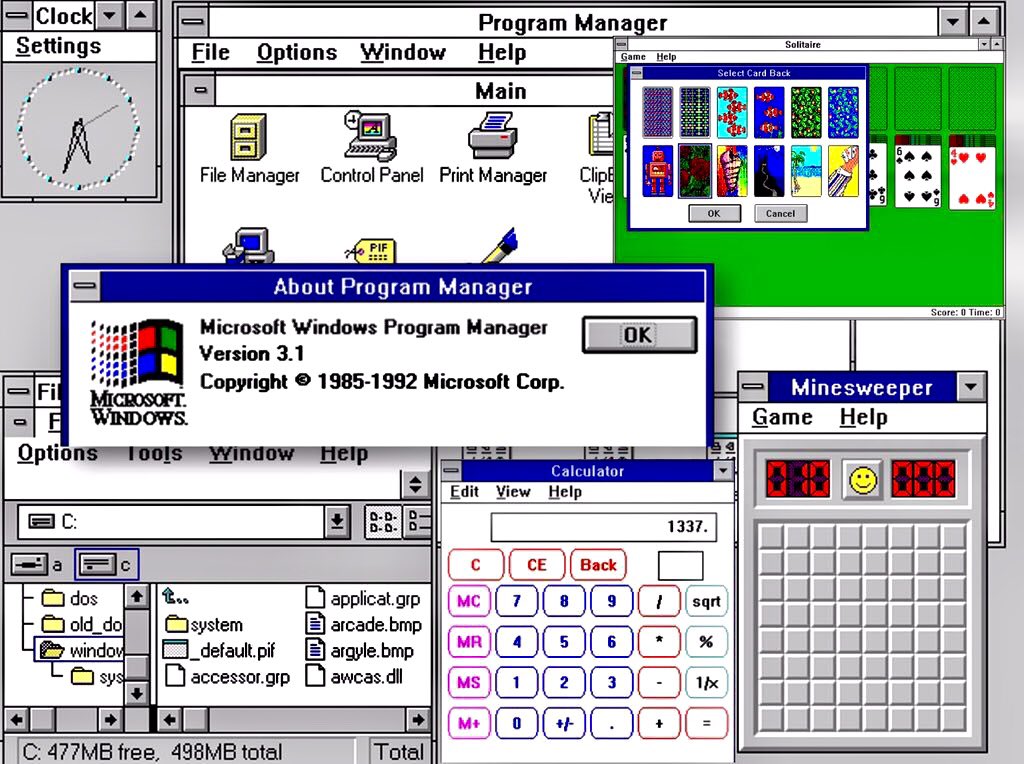Microsoft released Windows 3.1 on April 6, 1992, thirty years ago today. While Windows 95 was the game changer in terms of stability, functionality, marketing, and signalled the death knell of command line operating systems, it was Windows 3.1 that showed the platform could be taken seriously as a GUI, could host third party software, and was internet capable.
That was its highlight. The other things Microsoft did with Windows 3.1 were regrettable, despicable, and unforgivable.

First, Win3.1 started the ever growing feedback loop and arms race of computing. Windows 3.0 could run on an 8086 computer, but Windows 3.1 ran only on 80286 in protected mode with 1 MB of RAM. This forced users to buy new machines (what the industry calls “upgrading”) despite the fact their current machines still worked fine. This led to the vicious and environmentally wasteful cycle:
new operating system requires new computer
new computer is able to run a newer operating system
Second, Windows 3.1 is where Microsoft’s unethical and criminal business practices really ramped up. Users of Digital Research’s DR-DOS were able to run Windows 3.0. However, they could not run Windows 3.1. This was not any failing of DR-DOS, which was fully capable of doing so. Rather, it was due to code Microsoft intentionally writing code in Windows 3.1 that detected your version of DOS. It is referred to as the AARD Code.
If you were running PC-DOS or MS-DOS, Windows 3.1 would start normally. If Windows detected DR-DOS, it would refuse to start, displaying a false “error message”. Digital Research tested and found the cause was Microsoft’s anti-competitive practices and filed suit. However, by the time the case was heard and decided, the damage was done. The public no longer trusted Digital Research’s products. The company was once a direct competitor of Microsoft (even after the mistake of not signing the deal with IBM that Microsoft did), but from then on it was a company in decline, eventually sold off to other companies.
How bad is Microsoft’s greed? So much so that decades old software which won’t run on modern computers (all their pre-NT operating systems) and would be too insecure or underpowered for today’s users, remains under copyright, not made available freely for collectors of old hardware.
From How To Geek: Windows 3.1 Turns 30: Here’s How It Made Windows Essential
Are there hardcore people still using Windows 3.1? Yes, and they made a Wordle clone for it.
Ars Technica: If you’re still on Windows 3.1, Windle is the best way to get in on the Wordle craze
And one more pointless piece of trivia:
Review Geek: An easter egg in Windows 1.0 has been found in 2002. 37 years later.

The nobbling of DR-DOS was, of course, only one instance of coding to break competitive products. I’ve heard (i.e. source long lost to my memory) that MS-DOS updates weren’t ready to ship if VisiCalc still worked (or was it Lotus 1-2-3?).
Windows 3.1 was also where Microsoft really started playing the secret interface game. Windows operating system and interface components have multiple program interfaces. Which is pretty inherent to anything as complex as an operating system or a graphical interface. What Microsoft did that was illegal is have a public interface and a secret better one known only to Microsoft. The secret interface had extra features or worked better then the public one, making Microsoft programs better then programs from competitors.
This was one of the major elements of the Microsoft monopoly trial. The eventual settlement required that Microsoft make the entire code available to a group of independent auditors that would make sure that all application interfaces had documentation.
When talking about the PC market in the Windows 95 and prior times it’s hard to even begin to cover all of the unethical practices of Microsoft. Microsoft has cleaned up it’s practices since 2000, just being a run of the mill contemptible big company. There was a time that Microsoft was arguable a criminal enterprise, only able to hold on to it’s market position by using monopoly power to force companies to give it advantages. It forced hardware companies to bundle Windows with every PC to secure it’s market share while using it’s market share to force software companies to give it favored treatment.
Silly me, I forgot about that one. Having special systems calls for your own products is akin to telling developers, “You get to use an interpreter, we get to use a compiler.”
The two things that make Microsoft more tolerable than Apple when it comes to software are (a) third party software is more readily available, often cheap or even free, and (b) backwards compatibility. Apple seems intent on making each new OS version incompatible with the past, or at least anything more than one version previous. With Windows, pretty much anything up to 20 years old is still usable, and prior to Windows 7, most software going back to 1980.